
Gerard David was an Early Netherlandish painter and manuscript illuminator known for his brilliant use of color. Only a bare outline of his life survives, although some facts are known. He may have been the Meester gheraet van brugghe who became a master of the Antwerp guild in 1515. He was very successful in his lifetime and probably ran two workshops, in Antwerp and Bruges. Like many painters of his period, his reputation diminished in the 17th century until he was rediscovered in the 19th century.

Antonio Allegri da Correggio, usually known as just Correggio, was the foremost painter of the Parma school of the High Italian Renaissance, who was responsible for some of the most vigorous and sensuous works of the sixteenth century. In his use of dynamic composition, illusionistic perspective and dramatic foreshortening, Correggio prefigured the Baroque art of the seventeenth century and the Rococo art of the eighteenth century. He is considered a master of chiaroscuro.

Aachen Cathedral is a Roman Catholic church in Aachen, Germany and the seat of the Roman Catholic Diocese of Aachen.
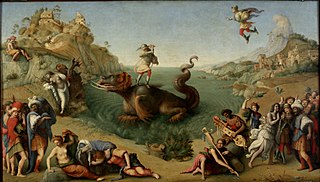
Piero di Cosimo, also known as Piero di Lorenzo, was an Italian painter of the Renaissance.

Adriaen Isenbrandt or Adriaen Ysenbrandt was a painter in Bruges, in the final years of Early Netherlandish painting, and the first of the Dutch and Flemish Renaissance painting of the Northern Renaissance. Documentary evidence suggests he was a significant and successful artist of his period, even though no specific works by his hand are clearly documented. Art historians have conjectured that he operated a large workshop specializing in religious subjects and devotional paintings, which were executed in a conservative style in the tradition of the Early Netherlandish painting of the previous century. By his time, the new booming economy of Antwerp had made this the centre of painting in the Low Countries, but the previous centre of Bruges retained considerable prestige.

Francesco Francia, whose real name was Francesco Raibolini was an Italian painter, goldsmith, and medallist from Bologna, who was also director of the city mint.
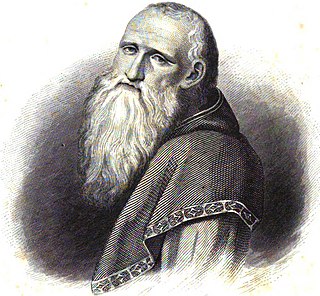
Bernardino Luini was a north Italian painter from Leonardo's circle during the High Renaissance. Both Luini and Giovanni Antonio Boltraffio were said to have worked with Leonardo directly; he was described as having taken "as much from Leonardo as his native roots enabled him to comprehend". Consequently, many of his works were attributed to Leonardo. He was known especially for his graceful female figures with elongated eyes, called Luinesque by Vladimir Nabokov.

Giovanni Battista Cima, also called Cima da Conegliano, was an Italian Renaissance painter, who mostly worked in Venice. He can be considered part of the Venetian school, though he was also influenced by Antonello da Messina, in the emphasis he gives to landscape backgrounds and the tranquil atmosphere of his works. Once formed his style did not change greatly. He mostly painted religious subjects, often on a small scale for homes rather than churches, but also a few, mostly small, mythological ones.

Jacob Claesz van Utrecht, also named by his signature Jacobus Traiectensis was a Flemish early Renaissance painter who worked in Antwerp and Lübeck.

Bernhard Strigel was a German portrait and historical painter of the Swabian school, the most important of a family of artists established at Memmingen. He was born at Memmingen and was probably a pupil of Zeitblom at Ulm. He stood in high favor with the Emperor Maximilian I, in whose service he repeatedly journeyed to Augsburg, Innsbruck, and Vienna.

Joos van Cleve was a leading painter active in Antwerp from his arrival there around 1511 until his death in 1540 or 1541. Within Dutch and Flemish Renaissance painting, he combines the traditional techniques of Early Netherlandish painting with influences of more contemporary Renaissance painting styles.
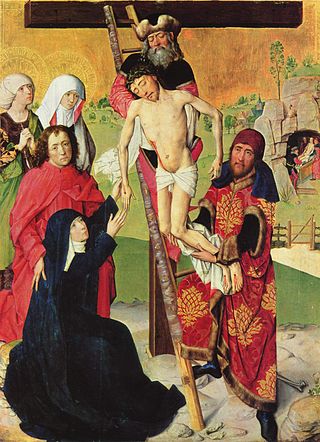
The Master of the Life of the Virgin, in German the Meister des Marienlebens,, is the pseudonym given to a late Gothic German painter working in Cologne. He can also be known as the Master of Wilten, or Johann van Duyren, an identification not universally accepted.
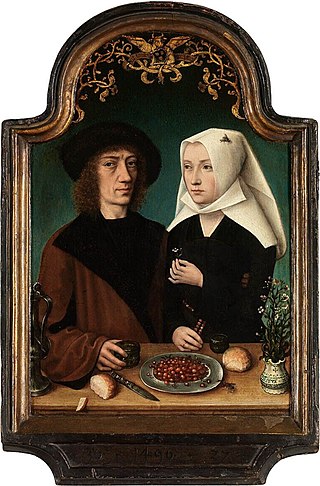
The Master of Frankfurt was a Flemish Renaissance painter active in Antwerp between about 1480 and 1520. Although he probably never visited Frankfurt am Main, his name derives from two paintings commissioned from patrons in that city, the Holy Kinship in the Frankfurt Historical Museum and a Crucifixion in the Städel museum.

The Master of the Saint Bartholomew Altarpiece was an Early Netherlandish painter active in Germany, mostly Cologne, between 1475/1480 and 1510. Despite his anonymity, he is one of the most recognizable artists of the early Renaissance period in German art.

The Monforte Altarpiece is an oil on oak panel painting of the Adoration of the Magi by the Flemish painter Hugo van der Goes, now in the Gemäldegalerie, Berlin, Germany. The altarpiece was originally the central panel of a triptych with movable wings that are now lost; these were probably painted on both sides. This is shown by the hinges remaining in the original frame. Old copies of the work show the Nativity and Circumcision of Jesus on the wing panels. The central panel has been reduced in size at the top.
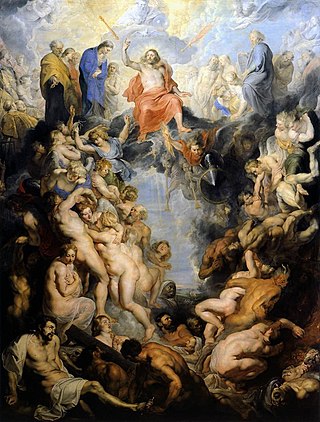
The Great Last Judgement is an oil on canvas altarpiece, painted by the Flemish artist Peter Paul Rubens between 1614 and 1617. He created the composition and final touches and his is the only signature on the work, though it is believed between nine and nineteen studio assistants also worked on it. Its name distinguishes it from the same artist's The Small Last Judgement of 1619 and his The Fall of the Damned of 1620.
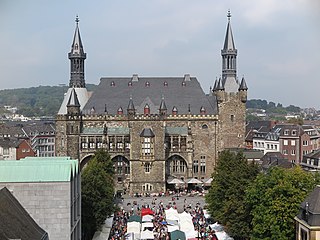
Aachen Town Hall is a landmark of cultural significance located in the Altstadt of Aachen, Germany. It was built in the Gothic architecture style in the first half of the 14th century.
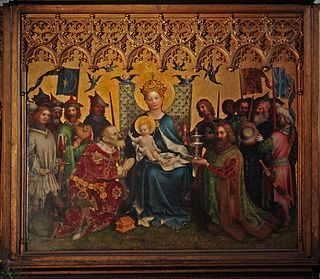
The term Cologne School of Painting was first applied in the 19th century to describe old German paintings generally. It subsequently came to refer more specifically to painters who had their workshops in medieval Cologne and the lower-Rhine region from about 1300 to 1550.

The Aachen Altar or Passion Altar (Passionsaltar) is a late gothic passion triptych in the Aachen Cathedral Treasury, made by the so-called Master of the Aachen Altar around 1515/20 in Cologne.

The Adoration of the Shepherds, is a c. 1515–1520 oil on panel painting of the Nativity by the German artist Lucas Cranach the Elder in the collection of the Gemäldegalerie Alte Meister in Dresden.





















